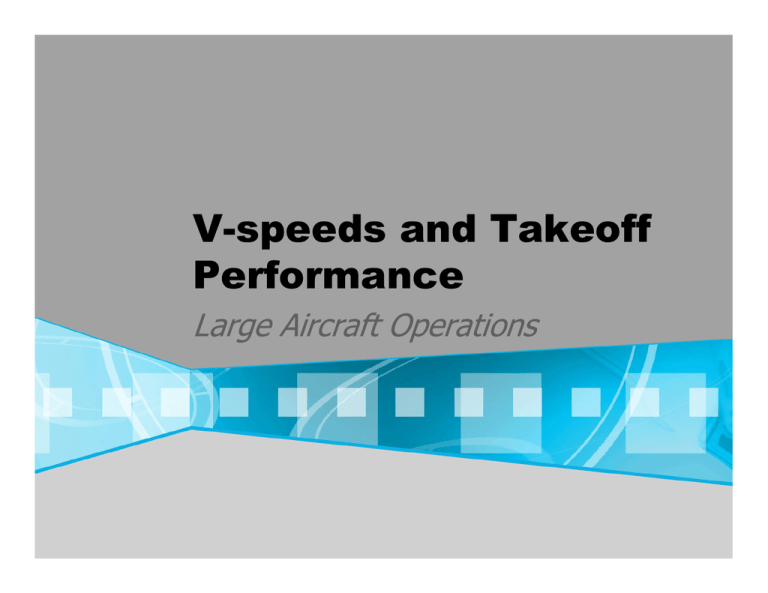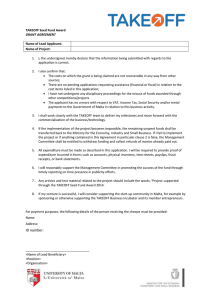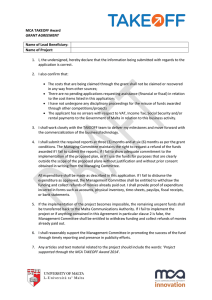V-speeds and Takeoff Performance
advertisement

V-speeds and Takeoff Performance Large Aircraft Operations What are V-speeds? • Large aircraft operate under a wide variety of weights, conditions and configurations. • Operators are subject to strict regulations governing aircraft performance during all phases of flight. (field length, net climb gradients) • Certain performance speeds are relative to operating conditions, and therefore change depending on the situation; these are known as V-speeds. Conditions Affecting V-speeds • V-speeds change relative to aerodrome conditions, • • • • aircraft weight and configuration. Gross takeoff weight, pressure altitude, and temperature all affect aircraft performance. WAT- weight, altitude, temperature. Aircraft configuration affects V-speeds (flap setting, slat setting, bleeds, anti-ice, a/c off/on, anti-skid inoperable), and can be used to improve performance. Runway conditions also affect V-speeds. (contaminated runway) V-speed Definitions • V1- Takeoff Decision Speed- the speed which dictates whether a malfunction during the takeoff roll results in rejecting the takeoff, or continuing. (go or no go speed) • VR- Takeoff Rotation Speed- the speed at which aircraft rotation is initiated by the pilot. • V2- Minimum Takeoff Safety Speed- one engine inoperative climb speed for takeoff configuration. • VMCG- Ground Minimum Control Speed- minimum speed which provides directional control on the ground during failure of the critical engine. • VMCA- Air minimum Control Speed- minimum speed which provides directional control in the air during failure of the critical engine. • VMU- Minimum Unstick Speed- minimum speed the aircraft can lift off without demonstrating hazardous characteristics while continuing the takeoff. • VLO- Lift Off Speed- speed at which the aircraft will lift off. • VMBE- Maximum Brake Energy Speed- maximum speed an aircraft can initiate a rejected take off from and remain within heat limitations of the braking system. Relationships Between V-speeds V1 must always be >VMCG, <VMBE, ≤VR VR must always be ≥V1, >VMCA VLO must always be ≥VR, >VMCA, >VS, >VMU V2 must always be >VMCA, >VS, >VR These relationships will always hold true, but the speeds themselves will change according to aircraft weight, atmospheric conditions, aircraft configuration, and runway conditions. • V1, VR, and V2 will float between their minimum and maximum limits dependant on conditions and requirements. • The specific speeds are obtained by consulting the performance charts or quick reference cards. • • • • • V2 35’ VMCG V1 VMBE VMCA VR VS VMU VLO Takeoff Performance • During the certification process of an aircraft the manufacturer must comply with strict regulations concerning aircraft performance. Performance calculations are done assuming an engine failure at V1, a failure before or after will result in better than indicated performance. • Transport and Commuter aircraft takeoff field length is limited by the longer of: • Accelerate/stop distance- the distance required to accelerate to V1 with all engines operating normally, experience the loss of the critical engine and bring the aircraft to a stop. • Accelerate/go distance- the distance required to accelerate to V1 with all engines operating normally, experience the loss of the critical engine and continue with the takeoff and reach 35 feet above the runway at V2. • All-engine takeoff runway length- 115% of the distance required to reach 35 feet above the runway with all engines operating normally. Declared Distances AIM AGA 3.8 • In the determination of available runway length for take off the CAP aerodrome chart must be consulted. • Takeoff Run Available (TORA): The length of runway declared available and suitable for the ground run of an aeroplane taking off. • Takeoff Distance Available (TODA): The length of the takeoff run available plus the length of the clearway, where provided. (max. clearway length allowed is 1000 feet.) • Accelerate Stop Distance Available (ASDA): The length of the takeoff run available plus the length of the stopway where provided. Clearways and Stopways • Clearway- A defined rectangular area on the ground or water under the control of the appropriate authority, selected or prepared as a suitable area over which an aeroplane may make a portion of its initial climb to a specified height. (TODA-TORA) • Stopway- A defined rectangular area on the ground at the end of the runway in the direction of takeoff prepared as a suitable area in which an aeroplane can be stopped in the case of an abandoned takeoff (ASDA-TORA) Balanced Field Takeoff • A balanced field takeoff is a condition where the accelerate stop • • • • distance required (ASDR) is equal to the takeoff distance required (TODR) for a given WAT, aircraft configuration, and runway condition. When the takeoff field length is balanced it results in the shortest possible runway length for the given conditions. Performance charts are usually based on this balanced field concept as it allows for the highest takeoff weights to be achieved. The charts will give you the maximum takeoff weight allowable to depart a specific length of runway given the current conditions. The V-speeds generated by the charts assure adequate performance under the given conditions. Conditions Affecting Performance • The takeoff field length is dependant on the speed to which the aircraft has to be accelerated and the acceleration available. • WAT: weight, pressure altitude, and temperature. Increased weight, pressure altitude, and temperature decrease performance. • Engine thrust: Higher temperatures and lower air density reduce the amount of available thrust. Systems like A/C, bleed air, and anti-ice decrease available thrust. Thrust may be decreased purposely in order to maximize engine life if the runway length and aircraft weight allow it. (de-rated or reduced thrust takeoff) • Flap setting: flap configuration will depend on the limiting takeoff factor. Lower flap settings require longer takeoff distances but provide better climb out gradient capability. • Wind: A headwind will positively affect performance, decreasing both ASDR and TODR. A tailwind has a negative affect on performance. Performance charts are permitted to take credit for 50% of headwinds and 150% of tailwinds. • Runway slope: A down slope improves takeoff performance as long as brake energy doesn’t become limiting. • Surface condition: Contaminated runways will increase ASDR. • Anti-skid: An inoperative anti-skid system will increase ASDR. Questions • • • • • • • • • • • • • • If we increase V1, what effect will it have on ASDR and TODR? It will increase ASDR and decrease TODR. If we decrease V1, what effect will it have on ASDR and TODR? It will decrease ASDR and increase TODR. What effect will a wet runway have on ASDR? It will increase ASDR. What conditions have an effect on VMBE? Temperature, weight, runway slope, wind. Will cooler temperatures increase or decrease VMBE? Increase. Will increase in weight increase or decrease VMBE? Decrease. Will an upslope runway increase or decrease VMBE? Increase. • Is VMBE always greater or less than V1? Why? • It is always greater than V1 to ensure maximum brake temperatures are not • • • • • • • • exceeded during a RTO. Does the existence of a stopway or clearway allow for increased takeoff weights? Yes. In the above example will V1 change, if so will it increase or decrease? Yes it will increase to maximize use of a stopway, or decrease to maximize use of a clearway. Define balanced field takeoff. A balanced field takeoff exists when the ASDR is equal to the TODR. When would a reduced thrust takeoff be performed? Anytime aircraft weight, aerodrome conditions, and runway length allow it.





